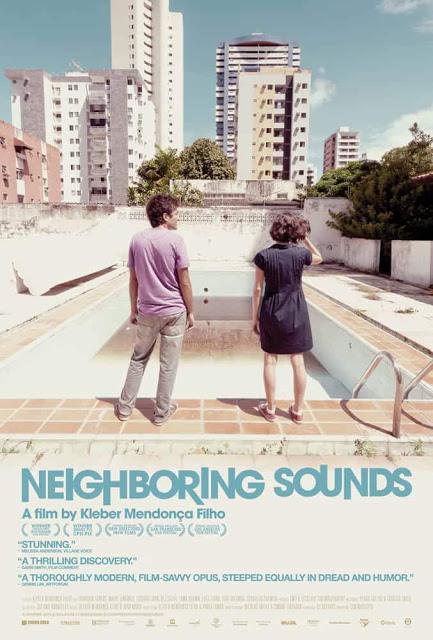 Film directors often make amazing debut feature films. These
debut films can be awesome if they are based on the director’s original scripts
rather than an adapted one. Kleber Mendonca Filho’s debut feature film Neighboring Sounds as a director stands
out as he has observed and reflected on the history of Brazil and created a
tale that mirrors the race conflicts and the closely related economic and social
disparity that has existed in recent decades of that wonderful, naturally
well-endowed nation’s history.
Film directors often make amazing debut feature films. These
debut films can be awesome if they are based on the director’s original scripts
rather than an adapted one. Kleber Mendonca Filho’s debut feature film Neighboring Sounds as a director stands
out as he has observed and reflected on the history of Brazil and created a
tale that mirrors the race conflicts and the closely related economic and social
disparity that has existed in recent decades of that wonderful, naturally
well-endowed nation’s history.
Beyond the interesting tale that director Filho wrote for his debut as a feature filmmaker, he evidently decided to build his tale aided by the importance of sounds in a film that most viewers neglect to notice. It is no coincidence that he chose to title the film as Neighboring Sounds. If a viewer approaches the film casually, the story of the film will be more overpowering than the diegetic sounds captured on the film’s soundtrack. Filho divides his film into three chapters (i) Guard Dogs, (ii) Night Guard, and (iii) Body Guards. The common phrase for all three is “guard.” At the end of the film, a perceptive viewer will mull over the emerging necessity of guards for certain sections of Brazilian society.
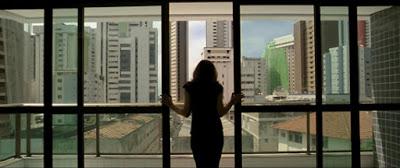
A view from an empty apartment in the condominium,
where a past resident committed suicide
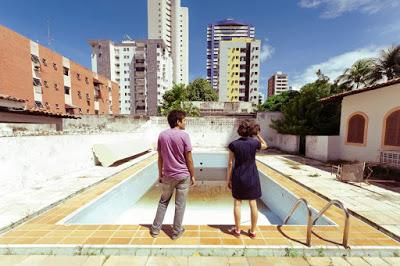
A swimming pool would make way for another upscale
apartment as the demand increases.
The film opens with the camera capturing historical sepia images of dark skinned workers of a plantation in Brazil with a huge imposing mansion in the background. The film then brings us back in full color to the modern-day crowded urban Brazil where fair-skinned Brazilians live in varied levels of upper middle-class comfort, with household help, dogs to guard some households and limited common areas with high walls for children to play and recreate with protection. Some of the inhabitants in the condominium and the locality are very rich, some are comparatively less affluent. In an early sequence of the feature film the viewer is introduced to calm locality in the city of Recife, where the calm exterior is shattered visually and aurally by a car suddenly speeding into view, hitting another car. That is the first taste that Filho gives the viewer that all is not well as it appears. A questioning viewer would wonder what that initial sequence was all about—but it would make sense as you absorb various such later incidents that dot the film. Most of the inhabitants are rich enough to employ maids and an old security guard that some inhabitants are not satisfied with and want replaced. Perhaps that is why one family in the condominium has a dog and the dog’s barking is a nuisance for another inhabitant who tries to kill the dog for the sake of a quiet night. One gets the impression that there is no crime in the area, only to realize that vehicles parked overnight are targets for thieves who find a market for stolen car music systems.

Some residents of the apartments are not as rich as others;
the lady above is a single mother of two kids, irritated by a
neighbor's dog barking at night and gets her kids to massage her
In the very first chapter, Filho’s script introduces the fact there is a very rich family with many close relatives residing in the neighborhood and even the old guard is a trusted man of this rich family’s current patriarch and therefore retained as a guard. Whether he is effective in his work or not, can be indirectly associated with the theft of a car music system. Filho’s film never spoon feeds the viewer. The viewer has to appreciate the mosaic of seemingly unrelated details to appreciate what the tale leads up to. The method employed by Filho brings to mind Lars von Trier’s amazing revenge tragedy Dogville (which also had a dog on the fringes of its tale), another remarkable film where the characters could be extrapolated beyond the limited geographical area presented that film to an entire country. Filho’s urban pocket of Recife (Brazil’s sixth largest city) is an encapsulated world of Brazil today that appears calm but is full of seething anger towards exploiters, past and present. In the second chapter, when “professional” guards seem to have replaced the old guard and the barking dog, the viewer is introduced to images and sounds of less privileged kids seeming to attack the well-to-do neighborhood residents using the cover of trees and terraces at night. Was that the reason for the guard dog to bark in the night? Filho’s film first suggests the sounds and visuals of these kids scurrying on tree-tops and roofs in the night as a dream of some residents, until the so-called new guards on duty catch hold of one of the kids hiding on a tree, only to let him go with a warning. The attitude of the guards towards the waif provides an interesting and unusual way to project the later events in the film that the viewer does not anticipate.
At day time, Filho introduces a sexual escapade between a guard and a maid in an apartment when the owner has stepped out and alerted the guard of his brief absence merely to guard the apartment. Filho surprises the viewer with a shot of a kid hurriedly departing from the supposedly empty apartment through the open doorway. The kid was evidently disturbed by the sounds of the activity of the guard and the maid who has never been inside that particular apartment.
Sounds matter in varied and surprising ways, in Neighboring Sounds, often contrasting the silence that reveal an important detail. Who was the kid? How come the guard was not aware that the empty house had a silent occupant? As the film progresses, those details make sense in the larger canvas offered by the film. In another sequence, the viewer glimpses the elderly don of the complex walking alone in the quiet night, evidently for a swim in the ocean, going past signs warning people of the sharks in the water. The guards watch their new employer with interest going for the swim alone and returning safely. All is calm but the uneasy calm grows on the viewer.

A new guard offers professional protection to residents,
who have experienced small crimes in the neighborhood

The night guards are recruited and on the job
Filho briefly takes the viewer and some of his characters away from Recife to the more interior areas of Brazil where the elderly don, his son, and the son’s girlfriend go for a swim near a waterfall and Filho gives the fresh water drenching them to surrealistically turn to the symbolic color of blood. Filho keeps the viewer guessing. the location of the waterfall is close to the large house shown in sepia color at the start of the film and a sugar plantation that the elderly patriarch's family owns. And right up to the very end of the film, the film discusses and insinuates bloody events that had happened and are likely to take place, without ever showing them on screen. The bloody waterfall, which is not real, is the closest Filho comes to “violence” shown in the film. there is also a passing mention of a recent suicide by a past inhabitant of the Recife condominium. And yet the film suggests violence in a very discreet way! That is what makes Neighboring Sounds stand out among contemporary films. It presents the simmering anger that results from social inequality over decades, with the “guards” displaying similar intolerant behavior they haveexperienced in the past from others. A single mother’s irritation towards barking dogs that is only alerting the denizens to dangers in the night is another subtext of the film offered by the screenplay.
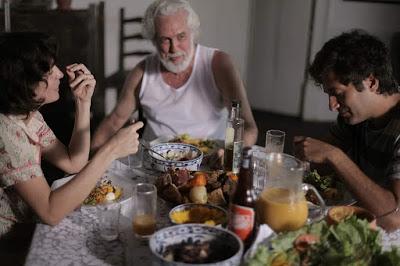
The family patriarch (center) shares a meal with his son
and the likely future daughter-in-law

The three visit locations near the patriarch's sugar plantation,
and shower at a nearby waterfall
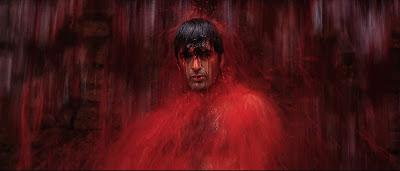
The water surrealistically turns to the color of blood
Filho’s film Neighboring Sounds anticipates his co-directed Bacurau (2019). Neighboring Sounds offers more style and sophistication than the later work. The use of sound in Neighboring Sounds does not predict events as most films tend to do—the lack of sound and the abrupt use of sound to aid the script are unusual and remarkable. In some ways, the film reminds you of the end sequence of Steven Spielberg’s debut film Duel (1971), in which a menacing truck falls off a cliff with a loud metallic groan, as though the inanimate truck had a life of its own. Filho is talented and this Brazilian film is a lot more sophisticated than Bacurau—the latter film having more mass appeal of a modern Western, while the former is more subtle in its message and linkages of disparate events.
Neighboring Sounds is an important film of the past decade, especially on the technical front, and is a treat for those who seek well made films. The film indirectly seems to ask if Brazilians today have learnt from the lessons of their history. The viewer can decide that.
P.S. Neighboring Sounds (2012) and The Fever (2019) are two remarkable debut films from Brazil in the last decade. The two films might not boast of the wider appeal of Bacurau (2019) with its violence and some nudity. Quite evidently, Brazilian cinema is on the march long after the days of Cinema Nuovo, mostly in the 1950s up to the 1970s (Glauber Rocha’s Black God, White Devil; Ruy Guerra’s The Guns; Leon Hirschzman’s The Girl from Ipanema; and Nelson Pereira dos Santos’ How Tasty was My Little Frenchman). The two films The Fever and Bacurau have been reviewed on this blog and both are among the author's Twenty Best Films of 2019. Neighboring Sounds has won 38 awards worldwide.

